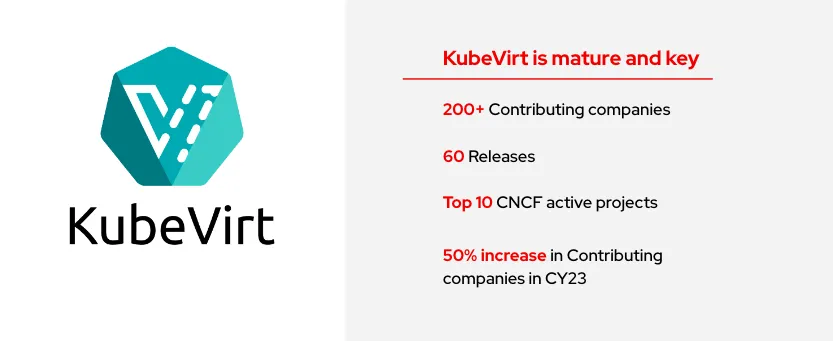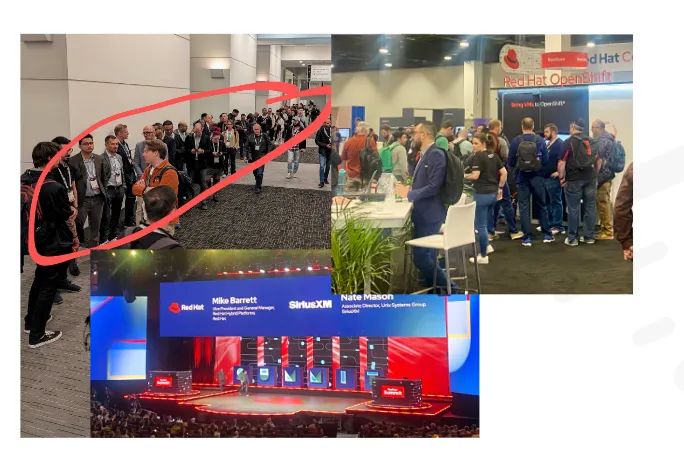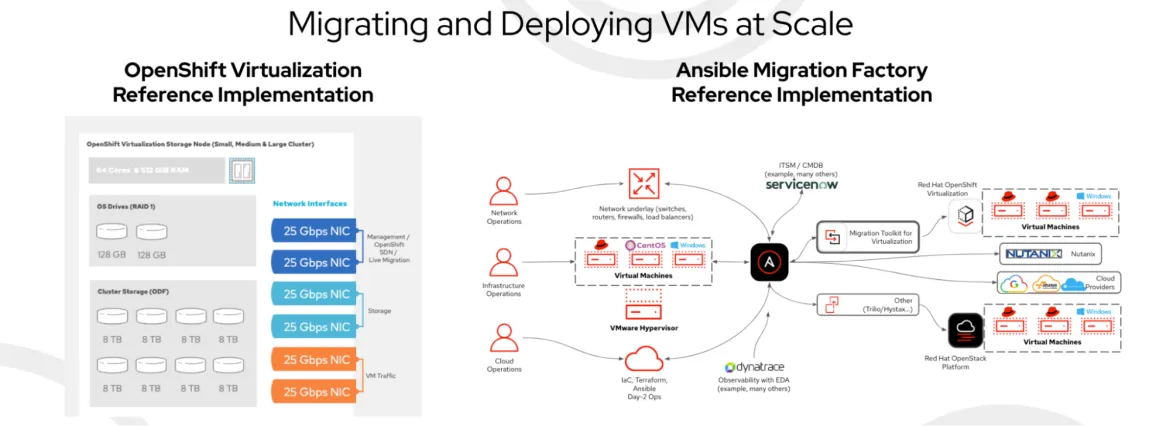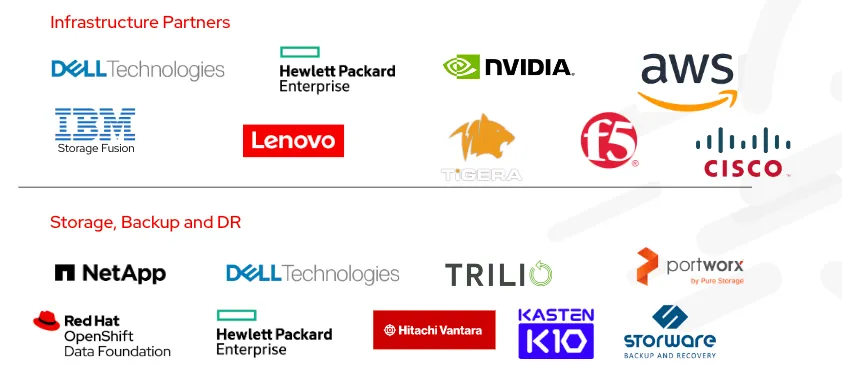Red Hat has a long history of involvement in virtualization technologies, beginning in the early 2000s, and we have continued to innovate and lead in the field through a number of projects and acquisitions. 2007 saw the introduction of Kernel-based Virtual Machine (KVM) as a robust, open source hypervisor in the Linux kernel, enabling efficient and scalable virtualization. Red Hat significantly deepened our virtualization capabilities by acquiring Qumranet, the company behind the KVM hypervisor, and KVM quickly became a cornerstone of our virtualization strategy. KVM has been widely adopted by major cloud providers due to its flexibility, performance and open source nature.
Red Hat engineers were also involved in the launch of the KubeVirt project. It started at the end of 2016 with the goal of enabling the management of virtual machines (VMs) within Kubernetes clusters. KubeVirt was a transformational idea of bringing virtualization natively into Kubernetes. Over time, it became the upstream default for running full traditional VMs orchestrated by Kubernetes. Kubernetes has transformed the industry with concepts of self healing, declarative life cycle management and a large ecosystem of projects.
KubeVirt has come a long way in the last seven years with over 200+ contributing companies, and it is currently a top 10 CNCF active project. The project moved to the sandboxed stage in 2019 and reached the incubating stage in 2022.
The project is now working towards the next CNCF milestone for graduation. There is good momentum as the annual KubeVirt Summit 2024 doubled the number of attendees and had 26 different speakers from companies like Red Hat, Intel, NVIDIA and Google.

KubeVirt was also featured in the 2024 KubeCon EU keynote with an enterprise end user discussing KubeVirt as a unified, open source and forward-looking platform, which they selected for running thousands of their existing VMs at scale.
In 2020, Red Hat announced the general availability of Red Hat OpenShift Virtualization which combines KubeVirt with the performance and stability of KVM. OpenShift Virtualization includes guest entitlement for Red Hat Enterprise Linux (RHEL), and Windows Guests are supported through Microsoft Server Virtualization Validation Program (SVVP).
Right place at the right time
All of that pre-work and soak time in the open source community and end user deployments from 2016 to 2022 placed OpenShift Virtualization in a fortunate position during the second half of 2023. Starting in 2023, usage of OpenShift Virtualization exploded as organizations began to look around for alternative virtual machine orchestrators. Many thought they would never need to investigate this topic in 2023. But this curiosity and interest in OpenShift Virtualization reached even greater heights in 2024. Interestingly enough, from 2016 to 2022 end users were primarily focused on modernizing how they integrate their VM orchestrator into cloud-native DevOps patterns. Topics like Argo, Tekton, Mesh, shared container networking, GitOps and resilience through horizontal scale were top of mind. OpenShift Virtualization is great at bringing those capabilities to virtual machines. But in 2023 into 2024 that focus shifted, and the bulk of the interest in OpenShift Virtualization became about safe migrations from traditional virtualization platforms. OpenShift Virtualization is perfect for both modernization and migration use cases. It is mature open source technology that is in the right place at the right time to help end users gain control of their datacenter budgets and projects.
The current state of OpenShift Virtualization
OpenShift Virtualization is currently powering mission-critical applications for investment banks, financial services, federal agencies, manufacturing, media, transportation, telco and more. Customers from these industries have presented their success stories at Red Hat Summit over the years.
For example, Sweden’s University of Gothenburg, one of Northern Europe’s largest and oldest universities, accelerated development and onboarded developers and students in minutes by adopting Red Hat OpenShift and OpenShift Virtualization for its data science website and research projects.
Turkish classified listing and e-commerce platform sahibinden.com is one of Turkey's most visited websites. To maintain its market-leading position against competition from start-ups and global retailers, they decided to adopt OpenShift and OpenShift Virtualization.
At Red Hat summit 2024, we also had several customers talk about their journey with Red Hat OpenShift.
SiriusXM, as part of the keynote, talked about migrating to OpenShift Virtualization and how this supported their modernization journey.
A large financial services institution talked about their journey of migrating thousands of VMs to OpenShift Virtualization for modernizing their private cloud.
Emirates NBD, one of the United Arab Emirates (UAE) largest banks, presented at OpenShift Commons and also conducted a customer roundtable sharing how they are revolutionizing their IT landscape by transitioning all workloads, including non-containerizable ones, to OpenShift.
You can check out more details about these stories and more here. We were thrilled to see such high interest that there were lines out the door to get into those sessions.

Interest in OpenShift Virtualization at Red Hat Summit 2024
Overall, OpenShift Virtualization is seeing tremendous growth across all verticals as reflected in the growth trends we are seeing across all of our adoption metrics.

12 months compare on growth metrics
We are seeing a diversity of workloads and operating systems moving to OpenShift Virtualization. RHEL and Windows are the top two guest operating systems but we also see a mix of other commercially and community supported Linux distributions. From a workload perspective, the most common workloads are application, web and database servers.
The acceleration is also across all verticals. Out of all the vertical markets, three are leveraging OpenShift the most. Media/technology, financial services and government are seeing rapid growth. Red Hat provides a unique combination of factors that are critical to these verticals, combined with the ability to adopt features that allow organizations to both innovate and deliver new features more quickly.

12 months compare on account growth in key verticals
What's next for OpenShift Virtualization?
The OpenShift Virtualization team continues to add new features and partner integrations.
The OpenShift Virtualization team has three main areas of focus, influenced by the close feedback loop we have with our customers, partners and technical sales teams.
1. Streamlined migrations

We have worked out a prescriptive methodology to help customers migrate at scale. This starts with having reference implementation guides and a migration factory that is driven at scale withRed Hat Ansible Automation Platform.
2. Enhanced capabilities
With the latest OpenShift Virtualization 4.16 release, its 12th release since it first GA in 2020, we have delivered some keenly anticipated features like CPU hotplug, a tech preview of memory overcommit, multicluster monitoring with Red Hat Advanced Cluster Management for Kubernetes, a disaster recovery solution for VMs, and the ability to pick a specific node for live migration. The next release is targeting memory hotplug, general availability of memory overcommit, dynamic resource balancing and a tech preview of non-disruptive VM storage mobility. From a networking perspective, upcoming enhancements to Open Virtual Network-Kubernetes (OVN-K) will integrate many of the virtualization networking requirements, making them part of the platform.
3. Enhancing the ISV ecosystem
We already have a rich ecosystem of partnerships for both OpenShift and OpenShift Virtualization. You can learn more about these ecosystem vendors in the catalog. We are working towards a tech preview of a virtual desktop infrastructure (VDI) integration with a leading VDI solution provider, and there are several backup vendors that have OpenShift Virtualization support on their roadmap in the next few months who will join the ones we already have in production. We also have planned integrations with additional major public cloud vendors who are just now introducing bare metal instance types. If you have a favorite cloud or service provider you would like to see us integrate with, please let us know.

Wrap up
It’s an exciting time for virtualization, and I hope this has been a helpful recap of where we are with OpenShift Virtualization.
I also hope you’ll join me at an upcoming OpenShift Virtualization Roadshow coming to a city near you. Explore our discounted learning paths to becoming an expert. Or learn more by exploring our e-book, "15 Reasons to Adopt Red Hat OpenShift Virtualization." This comprehensive guide highlights the key benefits and features that can help streamline your virtualization efforts and better future-proof your IT infrastructure. And if you feel overwhelmed and would like an objective partner to come in and assess how you are using your virtualization solution today to determine whether or not OpenShift Virtualization or a variety of alternatives on the market is a good fit, reach out about our two week migration assessment.
Sugli autori
Altri risultati simili a questo
Ricerca per canale
Automazione
Novità sull'automazione IT di tecnologie, team e ambienti
Intelligenza artificiale
Aggiornamenti sulle piattaforme che consentono alle aziende di eseguire carichi di lavoro IA ovunque
Hybrid cloud open source
Scopri come affrontare il futuro in modo più agile grazie al cloud ibrido
Sicurezza
Le ultime novità sulle nostre soluzioni per ridurre i rischi nelle tecnologie e negli ambienti
Edge computing
Aggiornamenti sulle piattaforme che semplificano l'operatività edge
Infrastruttura
Le ultime novità sulla piattaforma Linux aziendale leader a livello mondiale
Applicazioni
Approfondimenti sulle nostre soluzioni alle sfide applicative più difficili
Serie originali
Raccontiamo le interessanti storie di leader e creatori di tecnologie pensate per le aziende
Prodotti
- Red Hat Enterprise Linux
- Red Hat OpenShift
- Red Hat Ansible Automation Platform
- Servizi cloud
- Scopri tutti i prodotti
Strumenti
- Formazione e certificazioni
- Il mio account
- Supporto clienti
- Risorse per sviluppatori
- Trova un partner
- Red Hat Ecosystem Catalog
- Calcola il valore delle soluzioni Red Hat
- Documentazione
Prova, acquista, vendi
Comunica
- Contatta l'ufficio vendite
- Contatta l'assistenza clienti
- Contatta un esperto della formazione
- Social media
Informazioni su Red Hat
Red Hat è leader mondiale nella fornitura di soluzioni open source per le aziende, tra cui Linux, Kubernetes, container e soluzioni cloud. Le nostre soluzioni open source, rese sicure per un uso aziendale, consentono di operare su più piattaforme e ambienti, dal datacenter centrale all'edge della rete.
Seleziona la tua lingua
Red Hat legal and privacy links
- Informazioni su Red Hat
- Opportunità di lavoro
- Eventi
- Sedi
- Contattaci
- Blog di Red Hat
- Diversità, equità e inclusione
- Cool Stuff Store
- Red Hat Summit

